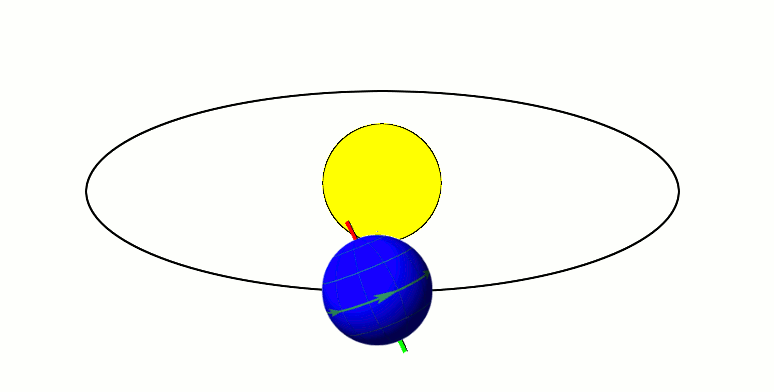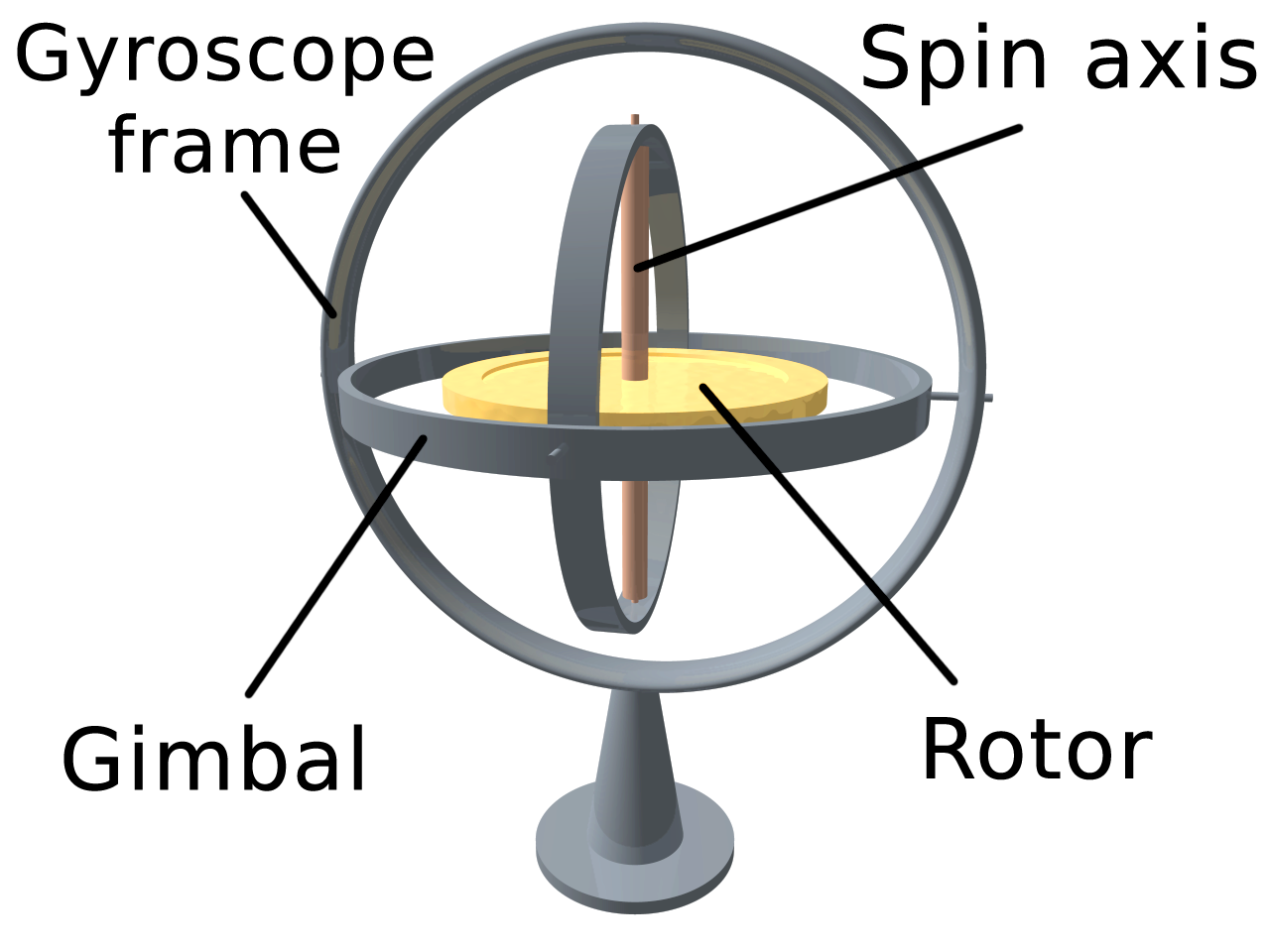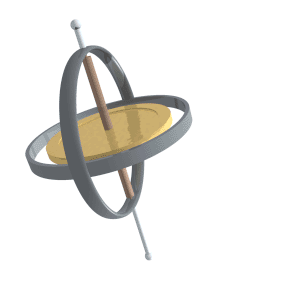|
Nutation
Nutation () is a rocking, swaying, or nodding motion in the axis of rotation of a largely axially symmetric object, such as a gyroscope, planet, or bullet in flight, or as an intended behaviour of a mechanism. In an appropriate reference frame it can be defined as a change in the second Euler angle. If it is not caused by forces external to the body, it is called free nutation or Euler nutation (after Leonhard Euler). A pure nutation is a movement of a rotational axis such that the first Euler angle is constant. Therefore it can be seen that the circular red arrow in the diagram indicates the combined effects of precession and nutation, while nutation in the absence of precession would only change the tilt from vertical (second Euler angle). However, in spacecraft dynamics, precession (a change in the first Euler angle) is sometimes referred to as nutation. In a rigid body If a top is set at a tilt on a horizontal surface and spun rapidly, its rotational axis starts precess ... [...More Info...] [...Related Items...] OR: [Wikipedia] [Google] [Baidu] |
Ecliptic
The ecliptic or ecliptic plane is the orbital plane of Earth's orbit, Earth around the Sun. It was a central concept in a number of ancient sciences, providing the framework for key measurements in astronomy, astrology and calendar-making. From the perspective of an observer on Earth, the Sun's movement around the celestial sphere over the course of a year traces out a path along the ecliptic against the fixed stars, background of stars – specifically the Zodiac constellations. The planets of the Solar System can also be seen along the ecliptic, because their orbital planes are very close to Earth's. The Moon's orbital plane is also similar to Earth's; the ecliptic is so named because the ancients noted that eclipses only occur when the Moon is crossing it. The ecliptic is an important Plane of reference, reference plane and is the basis of the ecliptic coordinate system. Ancient scientists were able to calculate Earth's axial tilt by comparing the ecliptic plane to that of ... [...More Info...] [...Related Items...] OR: [Wikipedia] [Google] [Baidu] |
Axial Precession
In astronomy, axial precession is a gravity-induced, slow, and continuous change in the orientation of an astronomical body's rotational axis. In the absence of precession, the astronomical body's orbit would show axial parallelism. In particular, axial precession can refer to the gradual shift in the orientation of Earth's axis of rotation in a cycle of approximately 26,000 years.Hohenkerk, C.Y., Yallop, B.D., Smith, C.A., & Sinclair, A.T. "Celestial Reference Systems" in Seidelmann, P.K. (ed.) ''Explanatory Supplement to the Astronomical Almanac''. Sausalito: University Science Books. p. 99. This is similar to the precession of a spinning top, with the axis tracing out a pair of cones joined at their apices. The term "precession" typically refers only to this largest part of the motion; other changes in the alignment of Earth's axis— nutation and polar motion—are much smaller in magnitude. Earth's precession was historically called the precession of the equinoxes, b ... [...More Info...] [...Related Items...] OR: [Wikipedia] [Google] [Baidu] |
Earth's Rotation
Earth's rotation or Earth's spin is the rotation of planet Earth around its own Rotation around a fixed axis, axis, as well as changes in the orientation (geometry), orientation of the rotation axis in space. Earth rotates eastward, in prograde motion. As viewed from the northern polar star Polaris, Earth turns counterclockwise. The North Pole, also known as the Geographic North Pole or Terrestrial North Pole, is the point in the Northern Hemisphere where Earth's axis of rotation meets its surface. This point is distinct from Earth's north magnetic pole. The South Pole is the other point where Earth's axis of rotation intersects its surface, in Antarctica. Earth rotates once in about 24 hours with respect to the Sun, but once every 23 hours, 56 minutes and 4 seconds with respect to other distant stars (#Stellar and sidereal day, see below). Earth's rotation is slowing slightly with time; thus, a day was shorter in the past. This is due to the tidal acceleration, tidal effects ... [...More Info...] [...Related Items...] OR: [Wikipedia] [Google] [Baidu] |
Euler Angles
The Euler angles are three angles introduced by Leonhard Euler to describe the Orientation (geometry), orientation of a rigid body with respect to a fixed coordinate system.Novi Commentarii academiae scientiarum Petropolitanae 20, 1776, pp. 189–207 (E478PDF/ref> They can also represent the orientation of a mobile frame of reference in physics or the orientation of a general Basis (linear algebra), basis in three dimensional linear algebra. Classic Euler angles usually take the inclination angle in such a way that zero degrees represent the vertical orientation. Alternative forms were later introduced by Peter Guthrie Tait and George H. Bryan intended for use in aeronautics and engineering in which zero degrees represent the horizontal position. Chained rotations equivalence Euler angles can be defined by elemental geometry or by composition of rotations (i.e. chained rotations). The geometrical definition demonstrates that three consecutive ''elemental rotations'' (rotatio ... [...More Info...] [...Related Items...] OR: [Wikipedia] [Google] [Baidu] |
Axial Tilt
In astronomy, axial tilt, also known as obliquity, is the angle between an object's rotational axis and its orbital axis, which is the line perpendicular to its orbital plane; equivalently, it is the angle between its equatorial plane and orbital plane. It differs from orbital inclination. At an obliquity of 0 degrees, the two axes point in the same direction; that is, the rotational axis is perpendicular to the orbital plane. The rotational axis of Earth, for example, is the imaginary line that passes through both the North Pole and South Pole, whereas the Earth's orbital axis is the line perpendicular to the imaginary plane through which the Earth moves as it revolves around the Sun; the Earth's obliquity or axial tilt is the angle between these two lines. Over the course of an orbital period, the obliquity usually does not change considerably, and the orientation of the axis remains the same relative to the background of stars. This causes one pole to be pointed mo ... [...More Info...] [...Related Items...] OR: [Wikipedia] [Google] [Baidu] |
James Bradley
James Bradley (September 1692 – 13 July 1762) was an English astronomer and priest who served as the third Astronomer Royal from 1742. He is best known for two fundamental discoveries in astronomy, the aberration of light (1725–1728), and the nutation of the Earth's axis (1728–1748). These two discoveries were called "the most brilliant and useful of the century" by Jean Baptiste Joseph Delambre, historian of astronomy, mathematical astronomer and director of the Paris Observatory. In his ''History of astronomy in the 18th century'' (1821), Delambre stated:"It is to these two discoveries by Bradley that we owe the exactness of modern astronomy. ... This double service assures to their discoverer the most distinguished place (after Hipparchus and Kepler) above the greatest astronomers of all ages and all countries." Biography Bradley was born at Sherborne, near Cheltenham in Gloucestershire, to William Bradley and Jane Pound in September 1692. His nephew John wa ... [...More Info...] [...Related Items...] OR: [Wikipedia] [Google] [Baidu] |
Axis Of Rotation
Rotation or rotational/rotary motion is the circular movement of an object around a central line, known as an ''axis of rotation''. A plane figure can rotate in either a clockwise or counterclockwise sense around a perpendicular axis intersecting anywhere inside or outside the figure at a ''center of rotation''. A solid figure has an infinite number of possible axes and angles of rotation, including chaotic rotation (between arbitrary orientation (geometry), orientations), in contrast to rotation around a fixed axis, rotation around a axis. The special case of a rotation with an internal axis passing through the body's own center of mass is known as a spin (or ''autorotation''). In that case, the surface intersection of the internal ''spin axis'' can be called a ''pole''; for example, Earth's rotation defines the geographical poles. A rotation around an axis completely external to the moving body is called a revolution (or ''orbit''), e.g. Earth's orbit around the Sun. The en ... [...More Info...] [...Related Items...] OR: [Wikipedia] [Google] [Baidu] |
External Ballistics
External ballistics or exterior ballistics is the part of ballistics that deals with the behavior of a projectile in flight. The projectile may be powered or un-powered, guided or unguided, spin or fin stabilized, flying through an atmosphere or in the vacuum of space, but most certainly flying under the influence of a gravitational field. Gun-launched projectiles may be unpowered, deriving all their velocity from the propellant's ignition until the projectile exits the gun barrel. However, exterior ballistics analysis also deals with the trajectories of rocket-assisted gun-launched projectiles and gun-launched rockets; and rockets that acquire all their trajectory velocity from the interior ballistics of their on-board propulsion system, either a rocket motor or air-breathing engine, both during their boost phase and after motor burnout. External ballistics is also concerned with the free-flight of other projectiles, such as balls, arrows etc. Forces acting on the projectile ... [...More Info...] [...Related Items...] OR: [Wikipedia] [Google] [Baidu] |
Gyroscope
A gyroscope (from Ancient Greek γῦρος ''gŷros'', "round" and σκοπέω ''skopéō'', "to look") is a device used for measuring or maintaining Orientation (geometry), orientation and angular velocity. It is a spinning wheel or disc in which the axis of rotation (spin axis) is free to assume any orientation by itself. When rotating, the orientation of this axis is unaffected by tilting or rotation of the mounting, due to the angular momentum#Conservation of angular momentum, conservation of angular momentum. Gyroscopes based on other operating principles also exist, such as the microchip-packaged Vibrating structure gyroscope#MEMS gyroscopes, MEMS gyroscopes found in electronic devices (sometimes called gyrometers), solid-state ring laser gyroscope, ring lasers, fibre optic gyroscopes, and the extremely sensitive quantum gyroscope. Applications of gyroscopes include inertial navigation systems, such as in the Hubble Space Telescope, or inside the steel hull of a submer ... [...More Info...] [...Related Items...] OR: [Wikipedia] [Google] [Baidu] |
Precession
Precession is a change in the orientation of the rotational axis of a rotating body. In an appropriate reference frame it can be defined as a change in the first Euler angle, whereas the third Euler angle defines the rotation itself. In other words, if the axis of rotation of a body is itself rotating about a second axis, that body is said to be precessing about the second axis. A motion in which the second Euler angle changes is called '' nutation''. In physics, there are two types of precession: torque-free and torque-induced. In astronomy, ''precession'' refers to any of several slow changes in an astronomical body's rotational or orbital parameters. An important example is the steady change in the orientation of the axis of rotation of the Earth, known as the precession of the equinoxes. Torque-free or torque neglected Torque-free precession implies that no external moment (torque) is applied to the body. In torque-free precession, the angular momentum is a constant, ... [...More Info...] [...Related Items...] OR: [Wikipedia] [Google] [Baidu] |
Angular Velocity
In physics, angular velocity (symbol or \vec, the lowercase Greek letter omega), also known as the angular frequency vector,(UP1) is a pseudovector representation of how the angular position or orientation of an object changes with time, i.e. how quickly an object rotates (spins or revolves) around an axis of rotation and how fast the axis itself changes direction. The magnitude of the pseudovector, \omega=\, \boldsymbol\, , represents the '' angular speed'' (or ''angular frequency''), the angular rate at which the object rotates (spins or revolves). The pseudovector direction \hat\boldsymbol=\boldsymbol/\omega is normal to the instantaneous plane of rotation or angular displacement. There are two types of angular velocity: * Orbital angular velocity refers to how fast a point object revolves about a fixed origin, i.e. the time rate of change of its angular position relative to the origin. * Spin angular velocity refers to how fast a rigid body rotates around a f ... [...More Info...] [...Related Items...] OR: [Wikipedia] [Google] [Baidu] |







